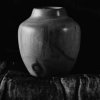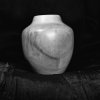Rob MacKillop
Edinburgh Correspondent
Just got back some exposures using the Nikon F4, with the 85mm 1.4 Nikon lens. I took a number of shots of this vase at different settings, some manual, some aperture priority. Generally almost all the shots are exposed to the right, one or two almost overexposed. Since taking these I bought a yellow filter, so we shall see what difference that makes. All XP2 at 400 ASA.
The first two are the same exposure. The second version has been put through Nik Silver Low Key 2, and cropped. I did this out of curiosity, to see what detail there was in the parts that are almost overexposed - it turns out there is a lot of detail. F5.6.


These two are at Aperture Priority F1.4

Again, Low Key 2 in Auld Nik:

This last is a manual exposure: F8 1/4". I'm not far away from what the camera was doing in Ap Priority.

Overall, I feel they are exposed too far to the right, so either the yellow filter will sort that out, or I'll be using -1 or -2 EV. They were developed by Ilford at some expense, almost twice what I pay Boots The Chemist, but the quality is on a much higher level. Boots jpgs are around 900kb to 1MB. The Ilford lot are averaging 8 to 9MB.
Thoughts?
The first two are the same exposure. The second version has been put through Nik Silver Low Key 2, and cropped. I did this out of curiosity, to see what detail there was in the parts that are almost overexposed - it turns out there is a lot of detail. F5.6.


These two are at Aperture Priority F1.4

Again, Low Key 2 in Auld Nik:

This last is a manual exposure: F8 1/4". I'm not far away from what the camera was doing in Ap Priority.

Overall, I feel they are exposed too far to the right, so either the yellow filter will sort that out, or I'll be using -1 or -2 EV. They were developed by Ilford at some expense, almost twice what I pay Boots The Chemist, but the quality is on a much higher level. Boots jpgs are around 900kb to 1MB. The Ilford lot are averaging 8 to 9MB.
Thoughts?
Last edited:


